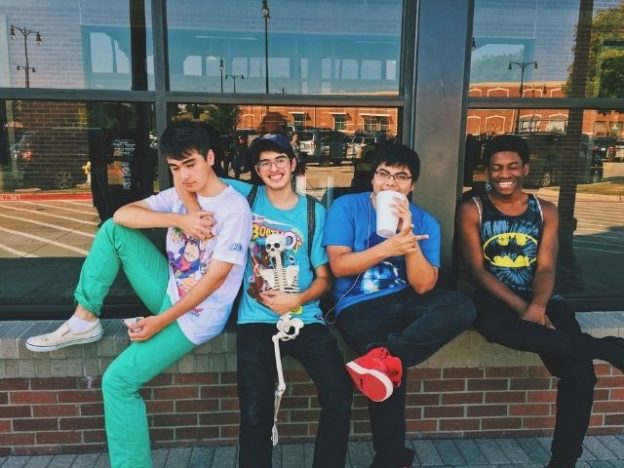One of the rising concepts in the teen and young adult drug and alcohol recovery world is the alternative peer group (APG) recovery approach as an effective follow-up approach to treatment for substance use disorder. The alternative peer group model for youth recovery is currently in use by programs around the country and has been presented as a more effective alternative to traditional approaches for young people. In this article, we will seek to present the available literature on the topic of APGs in order to present a clearer picture of what elements are present in the model, as well as its overall effectiveness in treating substance use disorders in young people.
What is the Alternative Peer Group Model for Youth Recovery?
Alternative peer groups are a term used for long-term aftercare or school programs that create a youth-specific approach to encouraging continued recovery from substance use disorders. This is in contrast to most adolescent programs, which tend to be modified variations of time-proven adult approaches to recovery. It has been noted that these programs have extremely high attrition rates and relapse rates when applied to young people. Nash et al submitted the following possible reasons for this in their 2016 paper The Alternative Peer Groups: A Developmentally Appropriate Recovery Support Model for Adolescents.
- Adolescents are more vulnerable to a rapid progression from substance use to dependence.
- Adolescents tend to be less motivated to seek recovery than adults.
- Adolescents are more likely than adults to relapse due to social pressures.
- Adolescents tend to show modest changes in substance use during treatment, but their progress in treatment fades extremely quickly once they leave the treatment environment.
A 2020 article published in the Substance Abuse: Research and Treatment Journal had the following to say about current outcomes for young people:
“Recovery and long-term remission are the goals of treatment for substance use disorders, yet the majority of treated adolescents never stop using or resume using substances quickly after treatment. Thus, continuing care or recovery support services are common post-treatment recommendations for this group. Almost half of people who resolved significant substance use problems did so through participation in 12-step programs like Alcoholics Anonymous or Narcotics Anonymous. These recovery support programs are available online and in communities around the world. Yet <2% of these programs’ members are under 21 years old.”
The alternative peer group is an approach to encouraging continued recovery in young people after treatment. The terminology was first presented by John Cates, MA, LCDC of Lifeway International in Houston, TX. John has over 40 years of experience in working with adolescents and young adults with drug problems. John first utilized this approach in his own efforts to help young people find and maintain a positive, sober way of life, but has since founded the Association of Alternative Peer Groups (AAPG) in order to allow other programs with similar approaches to utilize the model.
Elements of APGs and the theory behind them
While the elements of APGs are clearly presented on AAPG’s website, this 2011 paper by Collier et al. sought to understand the elements that make up the alternative peer group model. They discussed that the foundation of the approach is the social component and presented the elements as follows:
Six elements of an alternative peer group
- Youth must be present as participants in the program.
- Social functions such as afterschool hangouts, sober social weekend activities, and retreats.
- 12-step meetings for young people, since 12-step meetings are traditionally not well-attended by youth.
- Counseling for the individual, family, and group.
- Family Support
- Psychosocial Education for youth and parents.
The paper further goes on to discuss the clinical theory present in this unique approach:
Theoretical underpinnings of alternative peer groups
- 12-step principles, using modified language to be more inclusive of young people.
- Social influence theory, noting that adolescents have a higher rate of relapse due to peer pressure than adults, and that it has been shown that social influence has a positive effect on all sorts of risk behaviors in adolescents.
- Recovery capital, or increasing the presence of internal and external resources to initiate and maintain recovery.
Do APGs work? Quantitative data on the APG recovery model
To our knowledge, only one quantitative study has been done on alternative peer groups. In 2011, Rochat et al did a study comparing relapse rates in APGs to the national average. The study specifically mentions positive social influence and asks, “Can the same relationships that initiate and support use and dependence prove effective in facilitating recovery?”
What they found
- 50-90% relapse rate is typical for recovery programs.
- In January, 2008: 90% of clients who had completed IOP in 2006 were sober.
- In January, 2009: 89% were sober since 2007.
- In January, 2010: 92% were sober since 2008.
- Students enrolled in an APG high school had an 87% rate of staying sober the entire school year.
- APG high school students also had 89% school attendance, 96% graduation rate (for seniors), 79% student retention, and 96% of them went on to attend college.
The study goes on to report:
- Young people in APGs had significantly better perceptions of their inter-peer relationships than the control group.
- Parental satisfaction with APGs was overwhelmingly positive. Parents responded favorably to subjective questions about the APG’s role in helping them set effective boundaries, support their child’s recovery, and improve family relationships.
These results seem very compelling in favor of APGs as a viable method of approaching youth recovery. Note that this is just one study; we hope to see more quantitative data in the future.
Qualitative data on APGs
Upon investigation, two peer-reviewed qualitative studies were found regarding the efficacy of APGs:
Study #1: Exploring recovery capital among adolescents in an alternative peer group (2019)
“Recovery capital” is the term used to quantify how many tools and resources (both internal and external) a recovering substance user has available to them. This qualitative study utilized secondary analysis of interview data collected from APG participants.
What they found
Social Recovery Capital – Most participants reported having very few real friends before joining an APG. They also largely described their friends as being negative influences. Participants described developing very close bonds with their peers in APGs and described them as helpful. Also of note is that many participants described improvements in their family relationships. In particular, participants discussed that parents who got involved in recovery family groups had an easier time with this.
Community Recovery Capital – Participants largely reported that the APG’s atmosphere of fun and acceptance led to very good connections with peers in the APG who valued recovery. Also, 67% of the students reported attending a local recovery high school. They reported that the influence of positive peers helped them get past their initial objections to recovery.
Financial Recovery Capital – Participants primarily discussed parents’ or caregivers’ resources when speaking of financial resources which provided access to recovery options. One consistent theme that emerged was a lack of an existing youth agency in providing access to resources. Another subtheme was that some participants reported insurance restrictions as a barrier to recovery.
Human Recovery Capital – This category mainly refers to personal characteristics and internal assets, such as motivation, dedication to recovery, and a sense of accomplishment. Most participants initially reported low motivation, but that their motivation improved as they spent more time in the APG. They described a dedication to staying sober and a sense of accomplishment at staying sober or returning to recovery after a relapse.
Read the full article here.
Study #2: The Good, the Bad, and Recovery: Adolescents Describe the Advantages and Disadvantages of Alternative Peer Groups (2020)
In this study, researchers completed a secondary analysis of transcripts from interviews with adolescent APG participants collected from a prior study. The researchers analyzed recurring themes and attempt to determine that adolescents’ attitudes towards their experience in APGs.
What they found:
The results of the study expanded on four common themes among participants: belonging, meaning, structure, and ambivalence (with many subthemes). The results report:
APG factors that support recovery:
- Belonging – One of the most common themes was a sense of Participants described feeling welcomed, accepted, understood, loved, and more.
- Fun – A common subtheme mentioned by participants.
- Service – Participants reported receiving satisfaction and support for their own recovery by participating in the APG’s culture of giving back to the newer members of the group.
- Meaning – Most participants reported their APG experience was meaningful.
- Improved family dynamics – A common subtheme.
- Stories – Participants reported meaningful stories with positive peers.
- Structure – Almost all participants cited structure as one of the APG’s greatest benefits. The culture of scheduled meetings, social functions, and accountability was found to be a clear positive effect of APG participation.
- Positive recovery role models – Multiple participants discussed that the APG’s staff and support groups contained positive recovery role models who were helpful in peer mentoring staying sober.
Potential barriers to recovery:
- “Unhealthy groups” – A few participants mentioned feeling excluded, stigmatized, or disconnected within their respective APG’s if they were part of an unhealthy group.
- Alcohol / drug use – At least two of the study participants discussed that APG’s sometimes exposed adolescents to drugs they hadn’t done before, or exposed them to new drug-seeking peers.
- Hard work – At least two participants mentioned that being in an APG is “hard work.”
- Time consuming – At least two participants mentioned that being in an APG is very time consuming. One went into specific detail about struggling to juggle school, home life, and 5 nights per week of APG participation.
- Mandated attendance – One participant discussed that they would experience consequences if they didn’t attend all of the APG’s activities.
- Ambivalence – Four participants discussed conflicting or mixed feelings towards sobriety or recovery.
- Resistance to recovery – This was commonly expressed as a desire to get high, while also experiencing the benefits of their APGs.
- Not working the program – A few participants discussed not working the program because it was “hard work.” Multiple participants noted that over time, their resistance to working the program changed as they began to perceive the 12-steps as helpful.
Read the full article here.
In conclusion
At the core of the philosophy is something near and dear to our hearts as a program: the idea that (in general) young people need to be shown a better, more fun way of life before they are willing to let go of a drug or alcohol habit.
Whether you are a parent attempting to learn about treatment or recovery support systems available in your area or a clinician just trying to learn about the APG recovery approach generally, we hope this article has been helpful. While the elements of the approach go back to the 1970’s, the terminology is new enough that the body of evidence isn’t very large at this time. We hope to see more research come out in the coming years on the topic.
At the Pathway Program, we have been observing the positive effect of providing fun, engaging, and meaningful peer relationships to young people with drug problems has been having for many years. Feel free to take a look at The Pathway Program’s success rate or contact us if you have any questions. We will make efforts to keep this article up to date as new research is completed.






